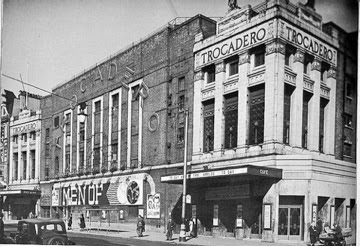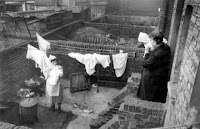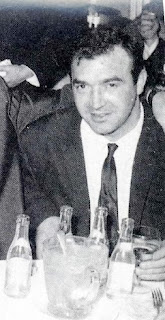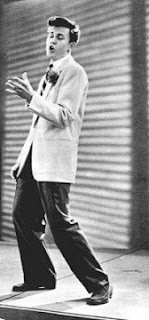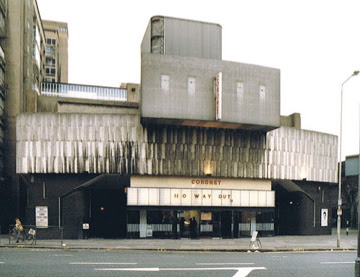His home was in the Holloway region north of London, and then divided from it by fields and trees. Between Battle Bridge and that part of the Holloway district in which he dwelt, was a tract of suburban Sahara, where tiles and bricks were burnt, bones were boiled, carpets were beat, rubbish was shot, dogs were fought, and dust was heaped by contractors.
Our Mutual Friend, Charles Dickens 1865
The Holloway Road, which is also part of the A1 and seemingly for ever traffic-choked, is unlike most of the surrounding area, in that it has always managed to resist gentrification. However much money is spent by the council and effort made, the second-hand furniture shops and cheap greasy cafes stubbornly remain, and probably always will.
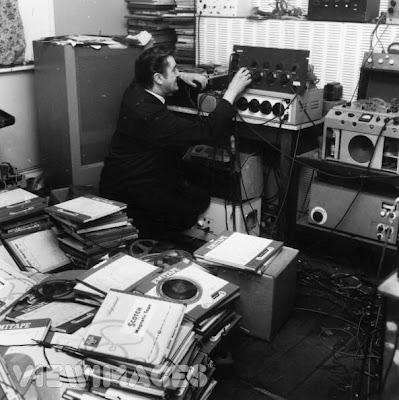 The maverick record producer Joe Meek had his home and studio in a flat above a leather shop at 304 Holloway Road, and although a lot of people probably think that the Beatles were the first big British success over in America, it was Margaret Thatcher’s favourite record – the Meek-produced Telstar by The Tornadoes that was the first UK recorded US number one in late 1962. Joe Meek produced hundreds of records, was a undoubtedly a visionary and huge influence on the record industry but in reality he only had a few other hits, albeit great records, such as ‘Just Like Eddie’ by Heinz, Johnny Remember Me by Johnny Leyton and the unforgettable, stomping Have I The Right by the Honeycombs.
The maverick record producer Joe Meek had his home and studio in a flat above a leather shop at 304 Holloway Road, and although a lot of people probably think that the Beatles were the first big British success over in America, it was Margaret Thatcher’s favourite record – the Meek-produced Telstar by The Tornadoes that was the first UK recorded US number one in late 1962. Joe Meek produced hundreds of records, was a undoubtedly a visionary and huge influence on the record industry but in reality he only had a few other hits, albeit great records, such as ‘Just Like Eddie’ by Heinz, Johnny Remember Me by Johnny Leyton and the unforgettable, stomping Have I The Right by the Honeycombs. Have I The Right was a record famous for having its drumming augmented by the group stamping on the stairs in the studio – a noise recorded by four microphones attached to the bannisters using bicycle clips.
Have I The Right was a record famous for having its drumming augmented by the group stamping on the stairs in the studio – a noise recorded by four microphones attached to the bannisters using bicycle clips.The success of The Beatles, The Rolling Stones and the so-called ‘Beat Boom’, however, suddenly seemed to make Meek’s production work old-fashioned, and his career certainly wasn’t helped after he was caught in a public toilet just off the Holloway Road and charged with “persistently importuning”. It was still four years away that homosexuality would be legalised and he was fined for ‘the crime’. The next day on the front page of the London Evening News he was named and shamed as ‘The Man Who Wrote Telstar’, and it brought his world crashing down around him.
Joe Meek deteriorated into depression and paranoia – he was once convinced that Decca Records had put hidden microphones behind his wallpaper in order to steal his ideas, something he also accused Phil Spector of, hanging up furiously after receiving an apparently innocent phone call from him.
Meek was also obsessed with the occult and he would set up tape recorders in graveyards in a strange attempt to record voices from beyond the grave, in one instance capturing the meowing of a cat he claimed was speaking in a human voice. In particular, he had an obsession with dead rock and roll stars especially Buddy Holly who he once claimed had communicated with him in dreams.
In the meantime, the hits had dried up and as Meek’s financial situation became increasingly desperate, his depression got worse. On February 3rd, 1967, not coincidentally the eighth anniversary of Buddy Holly’s death, Meek shot his landlady Violet Shenton and then himself with a single barrelled shotgun that he had confiscated from his protegé, former Tornados bassist and solo star Heinz Burt at his Holloway Road studio and kept under his bed along with some shells.
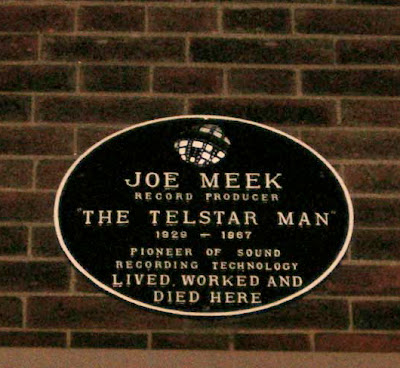
In 1970 John Lennon and Yoko Ono dropped by 95-101 Holloway Road – a complex of adjoining terraced housing and shops that had become the headquarters of several black separatist organisations and ran by a man born as Michael de Frietas but by now was calling himself Abdul Malik or more often Michael X – in tribute to the American Black power leader Malcolm X.
 De Frietas had unfortunately named the building ‘Black House’ – ironically the name Oswald Moseley had called his British Union of Fascists Chelsea headquarters in the 1930s. John and Yoko had arrived to partake in a publicity stunt for the headquarters where they were going to give for auction, very generously I’m sure you’ll agree, a bag of their own hair, that they had recently shorn off, in return for the bloody pair of shorts worn by Muhammad Ali, or Cassius Clay as he was then, when he defeated Henry Cooper at Highbury in 1966. The much-loved boxer had given them to de Frietas saying ‘here are my shorts stained with the blood of an Englishman’.
De Frietas had unfortunately named the building ‘Black House’ – ironically the name Oswald Moseley had called his British Union of Fascists Chelsea headquarters in the 1930s. John and Yoko had arrived to partake in a publicity stunt for the headquarters where they were going to give for auction, very generously I’m sure you’ll agree, a bag of their own hair, that they had recently shorn off, in return for the bloody pair of shorts worn by Muhammad Ali, or Cassius Clay as he was then, when he defeated Henry Cooper at Highbury in 1966. The much-loved boxer had given them to de Frietas saying ‘here are my shorts stained with the blood of an Englishman’.
Michael de Frietas has arrived in London in 1957 and became a pimp and drug pusher, eventually working as ‘protection’ and rent collector for the slum landlord Peter Rachmann (his excuse for this later was that Rachmann was one of the few landlords that would take West Indian tenants). He became heavily involved in black separatist politics by the mid-sixties and enjoyed a large cult following from the hip and fashionable . However his RAAS (Racial Adjustment Action Society) black power group was, in reality, largely a newspaper creation, with Malik as a scare figure. It all provided good copy and the newspapers were happy to massively exaggerate the membership numbers. In 1965 he became the first non-white person to be imprisoned (for 18 months) under the new Race Relations Act when he publicly urged the shooting of any black woman seen with a white man. He also responded, when asked what the establishm
. However his RAAS (Racial Adjustment Action Society) black power group was, in reality, largely a newspaper creation, with Malik as a scare figure. It all provided good copy and the newspapers were happy to massively exaggerate the membership numbers. In 1965 he became the first non-white person to be imprisoned (for 18 months) under the new Race Relations Act when he publicly urged the shooting of any black woman seen with a white man. He also responded, when asked what the establishm
ent should do about racism, that a black man should impregnate the Queen, so that they could rear a half-caste child. Predictable ‘shocked’ headlines followed.

Islington’s library is situated on the corner of Holloway Road and Fieldway Crescent, a few hundred yards up from Highbury Corner. It was here that in the late fifties and early sixties that the gay author and playwright Joe Orton, along with his lover Kenneth Halliwell, defaced 44 library books. The couple then hung around the library giggling every time an unsuspecting browser came across one of their obscene reviews typed carefully to fit in the dust-jackets of popular novels or an illustration swapped around from an incongrous book, for instance a nasty looking monkey would be placed in a gardening book where a picture of a rose should be.
defaced 44 library books. The couple then hung around the library giggling every time an unsuspecting browser came across one of their obscene reviews typed carefully to fit in the dust-jackets of popular novels or an illustration swapped around from an incongrous book, for instance a nasty looking monkey would be placed in a gardening book where a picture of a rose should be.
Influential playwright Joe Orton may have become, however the library at the time thought the humour schoolboyish and obscene, and somehow worked out that the defacing was almost certainly Orton and Halliwell. They sent the two of them a fake letter pretending it was from the Town Hall and accusing them of dumping a car near their flat in Islington and Halliwell typed a furious response. Unfortunately the Library found it easy to prove it was the same typewriter that had been used to deface the library books and the two of them got, what seems today to be an incredibly stiff sentence for what seems to be relatively trivial vandalism, six months in jail. They also had to pay 18 shillings and four pence (approximately 92p) in overdue library fines.
The library in its Joe Orton Collection keeps, rather hypocritically, what it still has of the defaced books as an archive of a local literary great.
 After 16 years together Halliwell ended up killing Orton by smashing him in the head with a hammer before he himself took an overdose of sleeping tablets. John Lahr in the biography of Orton Prick Up Your Ears described the scene like this:
After 16 years together Halliwell ended up killing Orton by smashing him in the head with a hammer before he himself took an overdose of sleeping tablets. John Lahr in the biography of Orton Prick Up Your Ears described the scene like this:
“Halliwell lay nude on his back in the centre of the room, three feet from Orton’s writing desk. The back of his hands, the top of his chest, and his bald head were splattered with blood. Except for his arms, rigor mortis had set in. Halliwell’s gory pyjama top was draped over the desk chair. On the linoleum floor near him was a glass and a can of grapefruit juice which had speeded the twenty-two Nembutals into his blood, killing him within thirty seconds. Halliwell had died sooner than Orton, whose sheets were still warm when the police discovered him in bed, his head cratered like a burnt candle.”

In Prick Up Your Ears - the film of the biography, written by Alan Bennett, Orton’s sister while mixing the ashes of Orton and Halliwell together says “I think I’m putting in more of Joe than of Kenneth.” “It’s a gesture, dear, not a recipe,” replies Vanessa Redgrave who played Orton’s agent.
Joe Orton and Joe Meek, two of the most famous gay men of the sixties both died in tragic circumstances within a few months of each other in 1967 – the very year that the Sexual Offences Act was passed by parliament that decriminalised homosexual acts, in private, between two men over the age of 21. Kenneth Halliwell, though, just couldn’t contain his jealousy and frustration with his lover’s sexual behaviour, private or otherwise. It was this behaviour written about very graphically in Orton’s diary that Halliwell’s brief suicide note alludes to:
If you read his diary, all will be explained. KH PS: Especially the latter part.
The Tornadoes – Telstar
The Honeycombs – Have I The Right
Just Like Eddie – Heinz
Buy Joe Meek stuff here


